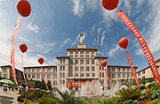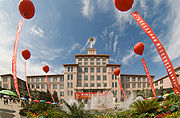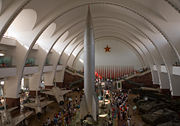
Military Museum of the Chinese People's Revolution
Encyclopedia
39°54′27.61"N 116°19′03.80"E

 The Military Museum of the Chinese People's Revolution, or China People's Revolution Military Museum (Chinese
The Military Museum of the Chinese People's Revolution, or China People's Revolution Military Museum (Chinese
: 中国人民革命军事博物馆) is a museum
located in Beijing
, China
immediately west of central Beijing
in Haidian District. It displays restored military equipment from the history of the People's Liberation Army
, up to and including modern-day machinery.
The museum's four floors include ten halls, the largest of which is the Hall of Weapons. The Hall's extensive holdings of antiquated weaponry showcase domestic and foreign weapons, including blades, small arms, artillery, tanks, armored personnel carriers, anti-air weaponry, jet fighters, rockets and rocket launchers, and cruise missiles. Foreign weapons include: Soviet tanks purchased or donated during the 1950s and 1960s, American
weaponry captured from the KMT during the Chinese Civil War
and from UN forces during the Korean War
, and Japanese
weaponry captured during the Sino-Japanese War
. In addition, the weapons hall displays equipment from China's space program, satellites and an orbital capsule with two seats.
With two exceptions, other halls are largely historical exhibits, combining plaster sculptures, maps and paintings, historical relics, movies, and plaques with text (in Chinese, with selected plaques translated into English). The other nine halls include the Hall of the Agrarian Revolutionary War (the 1927-1937 confrontation between the Chinese Communist Party with associated revolutionary forces, and the ruling KMT), the Hall of the War to Resist Japanese Aggression (the 1937-1947 Second Sino-Japanese War
), Hall of the War of Liberation of China (the 1945-1949 Chinese Civil War
), Hall of Ancient Wars (internal and external wars during the 4,000 years before the Qing dynasty), Hall of Modern Wars (internal and external wars between 1840 and 1949), Hall of National Defense and Army Building (modern military achievements and development of self-defense since 1949), Hall of the War to Resist US Aggression and Aid Korea (Chinese involvement in the Korean War
, 1951-1953), the Hall of Presents (gifts to the Chinese military or state by foreign militaries or states), and Hall of Cheng Yunxian's Sculptural Arts (plaster reproductions of sculptures of world leaders, historical figures, and scientists by Cheng Yunxian).
Currently there is no cost to enter the museum, as it is set up as a public service. The museum is accessible by Line 1
of the Beijing Subway
at the Military Museum Station
and City Bus Routes 1, 4, 21, 65, 68, 205, 308, 320, 337, 617, 728, and 802.


Chinese character
Chinese characters are logograms used in the writing of Chinese and Japanese , less frequently Korean , formerly Vietnamese , or other languages...
: 中国人民革命军事博物馆) is a museum
Museum
A museum is an institution that cares for a collection of artifacts and other objects of scientific, artistic, cultural, or historical importance and makes them available for public viewing through exhibits that may be permanent or temporary. Most large museums are located in major cities...
located in Beijing
Beijing
Beijing , also known as Peking , is the capital of the People's Republic of China and one of the most populous cities in the world, with a population of 19,612,368 as of 2010. The city is the country's political, cultural, and educational center, and home to the headquarters for most of China's...
, China
China
Chinese civilization may refer to:* China for more general discussion of the country.* Chinese culture* Greater China, the transnational community of ethnic Chinese.* History of China* Sinosphere, the area historically affected by Chinese culture...
immediately west of central Beijing
Beijing
Beijing , also known as Peking , is the capital of the People's Republic of China and one of the most populous cities in the world, with a population of 19,612,368 as of 2010. The city is the country's political, cultural, and educational center, and home to the headquarters for most of China's...
in Haidian District. It displays restored military equipment from the history of the People's Liberation Army
People's Liberation Army
The People's Liberation Army is the unified military organization of all land, sea, strategic missile and air forces of the People's Republic of China. The PLA was established on August 1, 1927 — celebrated annually as "PLA Day" — as the military arm of the Communist Party of China...
, up to and including modern-day machinery.
The museum's four floors include ten halls, the largest of which is the Hall of Weapons. The Hall's extensive holdings of antiquated weaponry showcase domestic and foreign weapons, including blades, small arms, artillery, tanks, armored personnel carriers, anti-air weaponry, jet fighters, rockets and rocket launchers, and cruise missiles. Foreign weapons include: Soviet tanks purchased or donated during the 1950s and 1960s, American
United States
The United States of America is a federal constitutional republic comprising fifty states and a federal district...
weaponry captured from the KMT during the Chinese Civil War
Chinese Civil War
The Chinese Civil War was a civil war fought between the Kuomintang , the governing party of the Republic of China, and the Communist Party of China , for the control of China which eventually led to China's division into two Chinas, Republic of China and People's Republic of...
and from UN forces during the Korean War
Korean War
The Korean War was a conventional war between South Korea, supported by the United Nations, and North Korea, supported by the People's Republic of China , with military material aid from the Soviet Union...
, and Japanese
Japan
Japan is an island nation in East Asia. Located in the Pacific Ocean, it lies to the east of the Sea of Japan, China, North Korea, South Korea and Russia, stretching from the Sea of Okhotsk in the north to the East China Sea and Taiwan in the south...
weaponry captured during the Sino-Japanese War
Second Sino-Japanese War
The Second Sino-Japanese War was a military conflict fought primarily between the Republic of China and the Empire of Japan. From 1937 to 1941, China fought Japan with some economic help from Germany , the Soviet Union and the United States...
. In addition, the weapons hall displays equipment from China's space program, satellites and an orbital capsule with two seats.
With two exceptions, other halls are largely historical exhibits, combining plaster sculptures, maps and paintings, historical relics, movies, and plaques with text (in Chinese, with selected plaques translated into English). The other nine halls include the Hall of the Agrarian Revolutionary War (the 1927-1937 confrontation between the Chinese Communist Party with associated revolutionary forces, and the ruling KMT), the Hall of the War to Resist Japanese Aggression (the 1937-1947 Second Sino-Japanese War
Second Sino-Japanese War
The Second Sino-Japanese War was a military conflict fought primarily between the Republic of China and the Empire of Japan. From 1937 to 1941, China fought Japan with some economic help from Germany , the Soviet Union and the United States...
), Hall of the War of Liberation of China (the 1945-1949 Chinese Civil War
Chinese Civil War
The Chinese Civil War was a civil war fought between the Kuomintang , the governing party of the Republic of China, and the Communist Party of China , for the control of China which eventually led to China's division into two Chinas, Republic of China and People's Republic of...
), Hall of Ancient Wars (internal and external wars during the 4,000 years before the Qing dynasty), Hall of Modern Wars (internal and external wars between 1840 and 1949), Hall of National Defense and Army Building (modern military achievements and development of self-defense since 1949), Hall of the War to Resist US Aggression and Aid Korea (Chinese involvement in the Korean War
Korean War
The Korean War was a conventional war between South Korea, supported by the United Nations, and North Korea, supported by the People's Republic of China , with military material aid from the Soviet Union...
, 1951-1953), the Hall of Presents (gifts to the Chinese military or state by foreign militaries or states), and Hall of Cheng Yunxian's Sculptural Arts (plaster reproductions of sculptures of world leaders, historical figures, and scientists by Cheng Yunxian).
Currently there is no cost to enter the museum, as it is set up as a public service. The museum is accessible by Line 1
Line 1, Beijing Subway
Line 1 of the Beijing Subway is the longest, oldest and busiest line of Beijing's mass transit rail network. It runs underneath Chang'an Avenue, the city's grand east-west thoroughfare, right through the heart of Beijing with stops on either side of Tiananmen Square...
of the Beijing Subway
Beijing Subway
The Beijing Subway is a rapid transit rail network that serves the urban and suburban districts of Beijing municipality. It is owned by the city of Beijing and has two operators, the wholly state owned Beijing Mass Transit Railway Operation Corp., which operates 12 lines, and the Beijing MTR...
at the Military Museum Station
Military Museum Station
Military Museum Station is a station on Line 1 of the Beijing Subway. It located near the Military Museum of the Chinese People's Revolution. The transfer to Line 9 is in construction....
and City Bus Routes 1, 4, 21, 65, 68, 205, 308, 320, 337, 617, 728, and 802.

